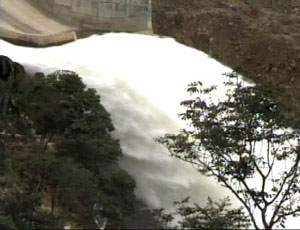Impact of
Reservoirs on the Flood Pulse--
Dams have a very strong impact on water balance in rivers. Dams are built
for several reasons, for example to generate electricity, to control floods,
for irrigated agriculture, to maintain flows for navigation and for domestic
water supply. Some dams fulfill more than one function. In all cases water
is stored behind the dam in a reservoir and released slowly according
to the needs of the user of the dam, however, differences in usage dictate
the way the dam is managed. For example, dams for flood control need the
maximum available volume before the beginning of the rainy season in order
to store the excess water arriving during the rains. Dams for irrigation
and electricity generation can maintain greater volume at the end of the
dry season and release excess water over the spillway as necessary. The
result of the operations of the dam on the hydrograph is to suppress the
peak floods during the rainy season and to even out the flow through the
dry season. This means that lake-like conditions can be created in the
river channel for some distance downstream of major dams as well as in
the upstream reservoir.
The suppression of the flood means that the floodplain is no longer flooded,
or is flooded to a greatly reduced extent. Lack of flooding  changes
the nature of the vegetation on the floodplain moving away from flood
dependent or flood tolerant species to drier forms. It also means that
much of the seasonal fauna disappears. In some areas of the world the
almost total control of wet season flow has led to the permanent occupation
of the floodplain for human habitation. In years of excessive rainfall,
however, so much water may be released over spillways as to re-flood the
plain, leading to catastrophic loss of life.
changes
the nature of the vegetation on the floodplain moving away from flood
dependent or flood tolerant species to drier forms. It also means that
much of the seasonal fauna disappears. In some areas of the world the
almost total control of wet season flow has led to the permanent occupation
of the floodplain for human habitation. In years of excessive rainfall,
however, so much water may be released over spillways as to re-flood the
plain, leading to catastrophic loss of life.
The presence of greater amounts of water in the river channel in the dry
season may, at first sight, appear beneficial. However most of the living
forms in rivers are highly adapted and dependent on the seasonal rise
and flow of the waters. The more stable hydrological regimes that occur
in rivers downstream of dams results in considerable changes in the species
and types of organisms present. There is, for instance, a tendency for
introduced species that may be better adapted to stable conditions, to
colonize the waters downstream. The full impact of dams is examined in
Section 13.
Impact of Water Transfers--
Transfers of water from one river basin to another, to provide drinking
water for cities or water for irrigated agriculture, are becoming increasingly
common. Transfers can be made by direct removal of water from a river,
but more usually involve some form of flow stabilization structure such
as a dam or weir. The recipient river usually has some form of storage
for the transferred water, such as a reservoir. In addition to the effects
of the dams themselves (see section 13), water transfers involve changes
to the hydrographs of both donor and recipient rivers. Water transfers
effectively rob one river in favor of another, but in so doing they alter
the timing and amount of water in both systems. The donor river receives
less water and removal at times of low flow can be particularly damaging
to living aquatic organisms downstream of the abstraction point. At the
same time, living resources in the river that receives the water may have
to adapt to amounts of water far in excess of the normal. This can damage
sedentary bottom living organisms, for example insects and molluscs.